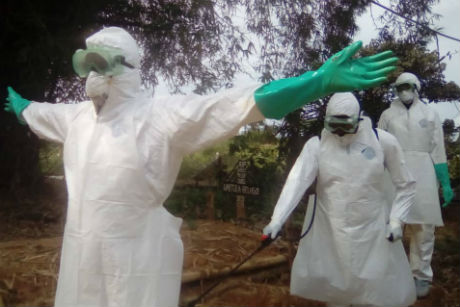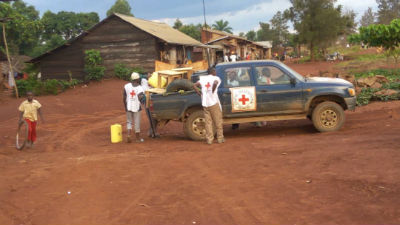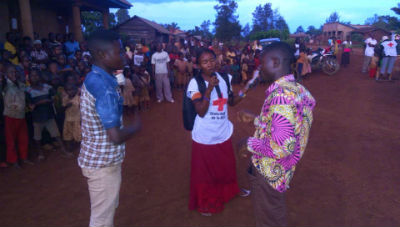 I have gone on missions to fight cholera, measles, and meningitis epidemics and assist people affected by floods, civil war, migration or food crises. That said, the Ebola missions are by far the most thankless and difficult I have ever experienced, especially because of the fear this disease causes.
I have gone on missions to fight cholera, measles, and meningitis epidemics and assist people affected by floods, civil war, migration or food crises. That said, the Ebola missions are by far the most thankless and difficult I have ever experienced, especially because of the fear this disease causes.Married for several weeks, Maryam*, 19, and Kakule live in a small village between Beni and Mangina. Along the road, they noticed checkpoints where Ministry of Health staff were taking people’s temperatures and asking them to wash their hands. Maryam and Kakule knew that it was to fight Ebola, but they had no idea where the virus came from. Some people said that it originated in Équateur Province, while others insisted that it was bats, the government, or even witchcraft.
One morning, Kakule woke up with a fever and wasn’t feeling well. Thinking that he had malaria, he went to the local health post for medication. The nurse suggested that he go to the Ebola treatment centre for testing. Kakule flatly refused, as he had heard that half the people who went in the centre died there. His situation worsened in the days that followed, but he still refused to go to the treatment centre despite the Ministry’s insistence.
 Maryam took care of her new husband as best she could, but she was powerless against the disease. When he succumbed, she spent much of the night crying while holding him in her arms. Kakule’s body was then returned to his home village, where, as per tradition, the patriarch announced the cause of death at the funeral. There was no doubt about it: witchcraft had taken Kakule to his grave.
Maryam took care of her new husband as best she could, but she was powerless against the disease. When he succumbed, she spent much of the night crying while holding him in her arms. Kakule’s body was then returned to his home village, where, as per tradition, the patriarch announced the cause of death at the funeral. There was no doubt about it: witchcraft had taken Kakule to his grave.Maryam found herself alone and grieving with a fever that crept higher with each passing day. She didn’t dare go to the health post because she was afraid of the Ministry people.
One week earlier, an older gentleman named Philémon had been taken by the Ministry people. Nobody had seen him since, and many believed him dead. In the village, Maryam heard him talking on speakerphone. In a hoarse voice, he told everyone that he was at the Ebola treatment centre, where he was eating three meals a day. The doctor was taking good care of him, and he was feeling better and better.
His message came through loud and clear. “Ebola is real, but it can be cured if you go to the treatment centre right away. Nobody burn down my hut, I’ll be back soon!” That very evening, Maryam took an ambulance to the centre.
Arriving at the centre can be intimidating. A team armed with a sprayer decontaminated the entire ambulance as soon as Maryam got out. They sat her on a small stool. The people questioning her were seated on the other side of an orange fence. Then two figures wearing large yellow plastic suits, white hoods and huge plastic goggles approached and spoke gently to her in her native language. “Don’t worry, we’ll take care of you…”
Maryam was diagnosed the same day that Philémon was discharged: he was cured. His whole family was waiting for him at the exit, where the treatment centre team gave him a certificate confirming that he was cured. The applause, tears of joy and hands voluntarily outstretched toward the survivor gave Maryam fresh courage.
After 10 days spent battling the disease, during which time she learned that the figures draped in plastic were named Moussa, Daniel, Sophie, Ange, Bahati and Éléa, Maryam finally had a second test come back negative. She had won!
Maryam is now involved in the fight against the virus. She goes door to door to tell her story in the market, in churches, and at public screenings of Ebola awareness films.
 We hear many stories like hers. Stories about orphans, broken homes, devastated families, and people who vanish into the forest and never return. In my team, 112 volunteers work day in and day out to conquer the disease. Slowly but surely, we are getting the sense that perceptions and behaviours are changing. Survivors are telling their stories. People are talking about the disease on the radio. Priests and imams are spreading the word to dispel myths and better combat the spread of this virus in their churches and mosques. This evening, I attended an awareness film screening. People laughed. Children danced. Maryam did a sketch with volunteers who handle safe burials. It was a great success. The film will be shown in several other villages.
We hear many stories like hers. Stories about orphans, broken homes, devastated families, and people who vanish into the forest and never return. In my team, 112 volunteers work day in and day out to conquer the disease. Slowly but surely, we are getting the sense that perceptions and behaviours are changing. Survivors are telling their stories. People are talking about the disease on the radio. Priests and imams are spreading the word to dispel myths and better combat the spread of this virus in their churches and mosques. This evening, I attended an awareness film screening. People laughed. Children danced. Maryam did a sketch with volunteers who handle safe burials. It was a great success. The film will be shown in several other villages.In short, the tide is starting to turn in our favour in the fight against the epidemic. Seeing the people on the front lines continue their involvement after going through hell motivates us to carry on.
* Due to privacy concerns, Maryam is not her real name.

